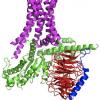I don't know what I'm ill informed about with regards to FOXO3 but it was highly unnecessary to mark my post as being ill informed, since I was asking a question and stating my confusion about the matter.
I just finished a round of D+Q at age 42 so you're probably right, I should just wait till 55 but if "inflammaging" is related to SASP from senescent cells, why do people begin to show signs of age so much sooner than 40? I realize there are other factors to aging than just senescent cells but it's something I would question given the above graph.
Someone also just gave me a "ill informed" vote, without uttering what's actually wrong...
Maybe it's because the senescent cell statistics is based on primates.(?)
If someone has accurate data on age + %-percent of senescent cells based on humans, you're welcome ! I personally couldn't find information about that.
To do senolytics you first have to know how much of senescent cells you have at which age.
So I made this exponential graph according to data from this article:
Quote:
the Brown team began to study aging animals - baboons living on a research preserve that ranged in age from 5 to 30. In human years, that age range is roughly 15 to 90. ... For replicative senescence, the most important biomarker is telomere dysfunction-induced foci, or TIFs. Presence of these structures signals that the protective chromosome caps called telomeres have dwindled enough to halt cell division. ... What they found: The number of senescent cells increased exponentially with age. TIF-positive cells made up about 4 percent of the connective tissue cell population in 5-year-olds. In 30-year-olds, that number rose as high as 20 percent.
Regarding your question on inflammation... As you said, lets not forget that there are also other pro-inflammatory factors while aging.
And that should not be a surprise since we know that for expample NAD+ and Glutathion levels go done after age 30, just to name 2 important.
(if my data is correct regarding humans) Significant inflammation by senescent cells is (imho) only a factor later in life, triggered by the degradation of other systems (for example autophagy).
But maybe someone has better intel about age and amount of senescent cells and at which age it would make sense to do senolytics.
Edited by Florian E., 10 April 2017 - 05:37 PM.
































































